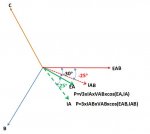BatmanisWatching1987
Senior Member
- Location
- NJ
- Occupation
- Jr. EE
A balanced delta load consist of three 20∠25° impedance. The 60 Hz line voltage is 208 V (rms).
I got the following values using the information above
Phase Current = 10.4∠-25° A
Line Current = 18∠-55° A
Phase Voltage = Line Voltage = 208V
What is the correct Total Power
Since
P3ø = (3)*Vp*Ip*cosθ = 3*208*10.4*cos(-25°) = 5882 W
P3ø = √3*Vl*Il*cosθ = √3*208*18*cos(-55°) = 3720 W.
Why I'm I getting 2 completely different answers?
I got the following values using the information above
Phase Current = 10.4∠-25° A
Line Current = 18∠-55° A
Phase Voltage = Line Voltage = 208V
What is the correct Total Power
Since
P3ø = (3)*Vp*Ip*cosθ = 3*208*10.4*cos(-25°) = 5882 W
P3ø = √3*Vl*Il*cosθ = √3*208*18*cos(-55°) = 3720 W.
Why I'm I getting 2 completely different answers?


